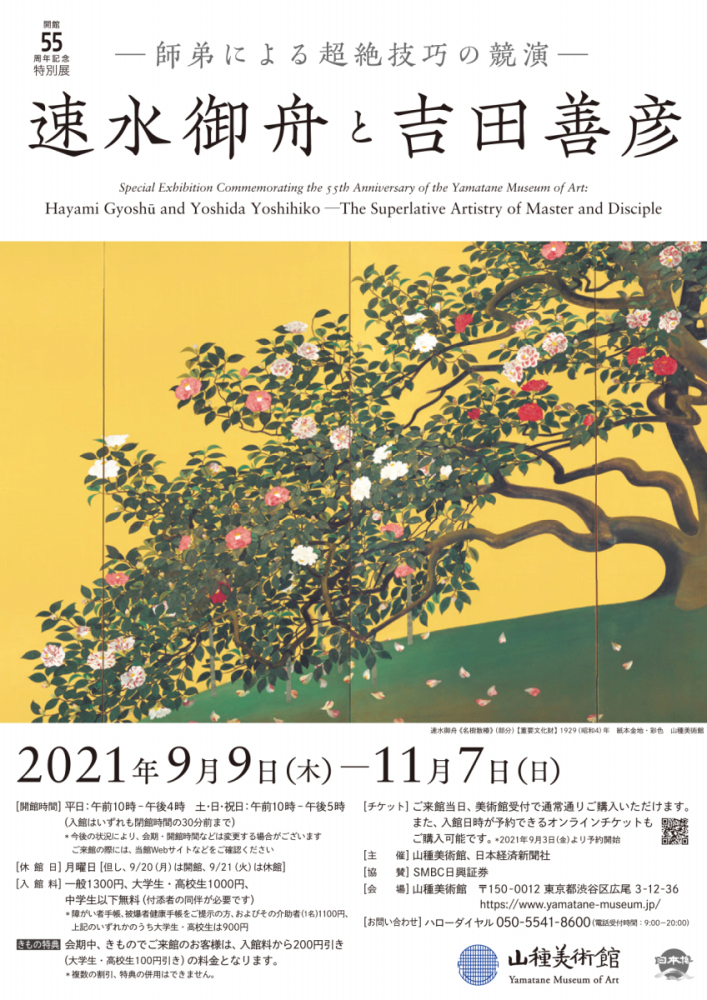Past Exhibition
Hayami Gyoshū and Yoshida Yoshihiko
―The Superlative Artistry of Master and Disciple

9 September (Wed.) – 7 November (Sun.) 2021
(Closed on 10 August and on Mondays, except for 20 September.)
Hours: Weekdays:10 am – 4 pm (Last admission at 3:30 pm)
Saturdays, Sundays, and national holidays: 10 am – 5 pm (Last admission at 4:30 pm)
Admission Fees: Adults: 1,300 yen; university and high school students: 1,000 yen; middle school and younger children: free of charge (but must be accompanied by an adult)
Disability ID holders and one person accompanying them: 1,100 yen (university and high school students: 900 yen)
*Discount for those who are wearing kimono: Discount of 200 yen for adults, 100 yen for university and high school students.
Organized by: Yamatane Museum of Art and Nikkei Inc.
Sponsored by: SMBC Nikko Securities Inc.
Approximately 60 works in total are to be displayed.
Works are the property of the Yamatane Museum of Art, except for works with ☆ marks.
Exhibition Overview
The Yamatane Museum of Art, which opened in 1966 as Japan’s first art museum specializing in Nihonga, celebrates its fifty-fifth anniversary in 2021. To commemorate that milestone, we are holding a special exhibition focusing on Hayami Gyoshū (1894-1935), the Nihonga artist who has become the face of our collection, and his student Yoshida Yoshihiko (1912-2001). We are pleased to present works created with these artists’ transcendent techniques.
Gyoshū, his work highly regarded by Yokoyama Taikan and Kobayashi Kokei, was recommended to join the Inten (Japan Art Institute Exhibition) when he was just twenty-three. As he said, ”The courage to climb to the top of the ladder is noble, while those who climb down from the perch and then climb back up it are all the more noble.” He constantly explored new styles and techniques, based on the classics, creating new currents in the Nihonga art world until his early death at the age of forty.
Yoshihiko began studying with Gyoshū, to whom he was related by marriage, at the age of seventeen, learning sketching, copying classic paintings, and approaches to painting from Gyoshū. He then participated in the project to copy the Hōryūji temple wall paintings, during and after World War II. Through those experiences, Yoshihiko found himself pursuing the weathered beauty of vintage paintings and creating his own artistic universe, denoted the “Yoshida style,” with his use of gold leaf and crumpled paper.
This exhibition includes, among works by Gyoshū, his Chrysanthemums, in which it has recently been determined that he used Western pigments, as well as his Camellia Petals Scattering, in which he used kinsunago, fine flecks of gold, scattered over the entire surface of the painting’s ground, a technique known as makitsubushi. They are joined by Dancing in the Flames (Important Cultural Property), in which he used colors that, he said, “I will never achieve again.” The works by Yoshihiko on display include his Katsuragaki Fence, the first painting in which he employed the “Yoshida style,” and Great Buddha Hall in Spring Snow* and Mt. Myōgi in Spring Snow, in which he exhibited his mature mastery of that style. The exhibition introduces iconic works and other superb paintings by both artists.
Gyoshū and Yoshihiko are both painters who established their own unique styles, grounded in traditional techniques but incorporating their own precise, highly original, adaptations. We hope that this exhibition will introduce you to the worlds of transcendental technique that these artists pursued.
 Hayami Gyoshū, Peach Blossoms |
![Hayami Gyoshū, Dancing in the Flames [Important Cultural Property]](/upload/img2107-02.jpg) Hayami Gyoshū, Dancing in the Flames [Important Cultural Property] |
 Hayami Gyoshū, Emerald Mosses and Verdant Turf |
 Hayami Gyoshū, Chrysanthemums |
 Hayami Gyoshū, Black Peonies |
Unauthorized copying and replication of the contents of this site, text and images are strictly prohibited.






